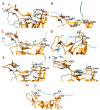Potential chimeric peptides to block the SARS-CoV-2 spike receptor-binding domain
- PMID: 32802318
- PMCID: PMC7411520
- DOI: 10.12688/f1000research.24074.1
Potential chimeric peptides to block the SARS-CoV-2 spike receptor-binding domain
Abstract
Background: There are no known medicines or vaccines to control the COVID-19 pandemic caused by SARS-CoV-2 (nCoV). Antiviral peptides are superior to conventional drugs and may also be effective against COVID-19. Hence, we investigated the SARS-CoV-2 Spike receptor-binding domain (nCoV-RBD) that interacts with hACE2 for viral attachment and entry. Methods: Three strategies and bioinformatics approaches were employed to design potential nCoV-RBD - hACE2 interaction-blocking peptides that may restrict viral attachment and entry. Firstly, the key residues interacting with nCoV-RBD - hACE2 are identified and hACE2 sequence-based peptides are designed. Second, peptides from five antibacterial peptide databases that block nCoV-RBD are identified; finally, a chimeric peptide design approach is used to design peptides that can bind to key nCoV-RBD residues. The final peptides are selected based on their physiochemical properties, numbers and positions of key residues binding, binding energy, and antiviral properties. Results: We found that: (i) three amino acid stretches in hACE2 interact with nCoV-RBD; (ii) effective peptides must bind to three key positions of nCoV-RBD (Gly485/Phe486/Asn487, Gln493, and Gln498/Thr500/Asn501); (iii) Phe486, Gln493, and Asn501 are critical residues; (iv) AC20 and AC23 derived from hACE2 may block two key critical positions; (iv) DBP6 identified from databases can block the three sites of the nCoV-RBD and interacts with one critical position, Gln498; (v) seven chimeric peptides were considered promising, among which cnCoVP-3, cnCoVP-4, and cnCoVP-7 are the top three; and (vi) cnCoVP-4 meets all the criteria and is the best peptide. Conclusions: To conclude, using three different bioinformatics approaches, we identified 17 peptides that can potentially bind to the nCoV-RBD that interacts with hACE2. Binding these peptides to nCoV-RBD may potentially inhibit the virus to access hACE2 and thereby may prevent the infection. Out of 17, 10 peptides have promising potential and need further experimental validation.
Keywords: ACE2; Antiviral peptides; COVID-19; SARS-CoV-2; Spike protein; nCoV-19; peptide design.
Copyright: © 2020 Barh D et al.
Conflict of interest statement
No competing interests were disclosed.
Figures



Similar articles
-
De novo design of protein peptides to block association of the SARS-CoV-2 spike protein with human ACE2.Aging (Albany NY). 2020 Jun 16;12(12):11263-11276. doi: 10.18632/aging.103416. Epub 2020 Jun 16. Aging (Albany NY). 2020. PMID: 32544884 Free PMC article.
-
Receptor Recognition by the Novel Coronavirus from Wuhan: an Analysis Based on Decade-Long Structural Studies of SARS Coronavirus.J Virol. 2020 Mar 17;94(7):e00127-20. doi: 10.1128/JVI.00127-20. Print 2020 Mar 17. J Virol. 2020. PMID: 31996437 Free PMC article.
-
Highly conserved binding region of ACE2 as a receptor for SARS-CoV-2 between humans and mammals.Vet Q. 2020 Dec;40(1):243-249. doi: 10.1080/01652176.2020.1823522. Vet Q. 2020. PMID: 32921279 Free PMC article.
-
COVID-19 pandemic: Insights into structure, function, and hACE2 receptor recognition by SARS-CoV-2.PLoS Pathog. 2020 Aug 21;16(8):e1008762. doi: 10.1371/journal.ppat.1008762. eCollection 2020 Aug. PLoS Pathog. 2020. PMID: 32822426 Free PMC article. Review.
-
Inhibition of S-protein RBD and hACE2 Interaction for Control of SARSCoV- 2 Infection (COVID-19).Mini Rev Med Chem. 2021;21(6):689-703. doi: 10.2174/1389557520666201117111259. Mini Rev Med Chem. 2021. PMID: 33208074 Review.
Cited by
-
Present and future treatment strategies for coronavirus disease 2019.Futur J Pharm Sci. 2021;7(1):84. doi: 10.1186/s43094-021-00238-y. Epub 2021 Apr 9. Futur J Pharm Sci. 2021. PMID: 33850936 Free PMC article. Review.
-
An Analysis Based on Molecular Docking and Molecular Dynamics Simulation Study of Bromelain as Anti-SARS-CoV-2 Variants.Front Pharmacol. 2021 Aug 20;12:717757. doi: 10.3389/fphar.2021.717757. eCollection 2021. Front Pharmacol. 2021. PMID: 34489706 Free PMC article.
-
Evidence supporting the use of peptides and peptidomimetics as potential SARS-CoV-2 (COVID-19) therapeutics.Future Med Chem. 2020 Sep;12(18):1647-1656. doi: 10.4155/fmc-2020-0180. Epub 2020 Jul 16. Future Med Chem. 2020. PMID: 32672061 Free PMC article.
-
Rationally Designed ACE2-Derived Peptides Inhibit SARS-CoV-2.Bioconjug Chem. 2021 Jan 20;32(1):215-223. doi: 10.1021/acs.bioconjchem.0c00664. Epub 2020 Dec 24. Bioconjug Chem. 2021. PMID: 33356169 Free PMC article.
-
Improvement of native structure-based peptides as efficient inhibitors of protein-protein interactions of SARS-CoV-2 spike protein and human ACE2.Front Mol Biosci. 2022 Sep 28;9:983014. doi: 10.3389/fmolb.2022.983014. eCollection 2022. Front Mol Biosci. 2022. PMID: 36250011 Free PMC article.
References
-
- Singh AK, Singh A, Shaikh A, et al. : Chloroquine and hydroxychloroquine in the treatment of covid-19 with or without diabetes: A systematic search and a narrative review with a special reference to india and other developing countries. Diabetes Metab Syndr. 2020;14(3):241–246. 10.1016/j.dsx.2020.03.011 - DOI - PMC - PubMed
MeSH terms
Substances
LinkOut - more resources
Full Text Sources
Other Literature Sources
Miscellaneous

